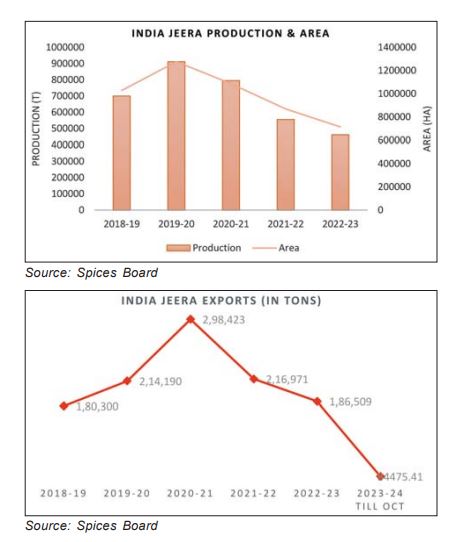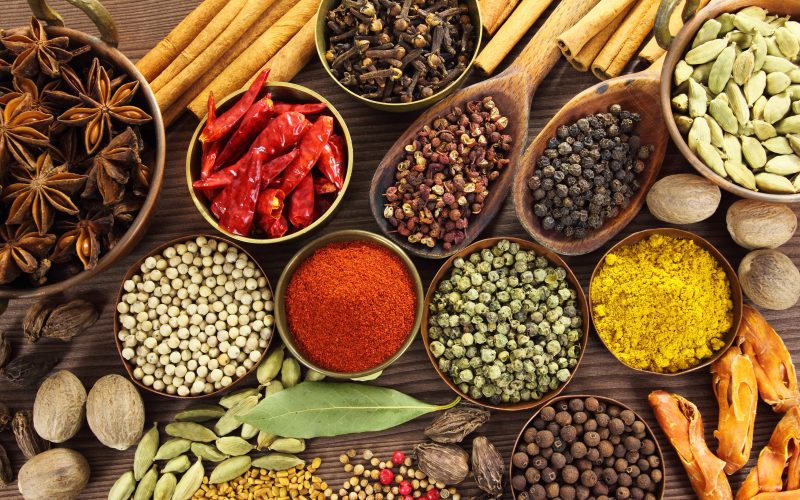Spices are an integral part of the Indian cuisine and culture. Lately, consumers are feeling the pinch of rise in prices of spices, some of which have skyrocketed. Spices are emerging as one of the factors contributing to the country’s rising food inflation rate, along with vegetables and pulses. According to data from the Ministry of Statistics and Programme Implementation of the Government of India, the Consumer Price Index, Rural and Urban, Spices Price Index have all been steadily rising. Although spices only account for 2.5 percent of inflation overall, price rises will have a significant impact on many other products due to their widespread use in food, confectionery, cosmetics, and other products.

India is a significant global producer, importer, and user of spices. The majority of spices produced in the nation are used within the nation. Although spices have been trending higher overall since the COVID-19 pandemic, in 2023 certain spices—like jeera, fennel, chilli, black pepper, turmeric, ginger, etc.—saw significant rallies. Before easing toward the end of the year, jeera reached a record high in 2023 and was quoted above Rs. 62,000 per quintal in the important spot market of Unjha, Gujarat. Similar fluctuations were observed in the price of chillies. Prices of ginger and turmeric eased at the end of 2023 following a spike between July and September. Price for ginger exceeded Rs. 40,000 per 100 kg in August before easing. Black pepper prices broke the Rs. 60,000 per 100 kg mark and hit a five year high, while small cardamom prices increased to a three-year high, with average auction prices approaching Rs. 2,000 per kg.

Source: Spices Board, Reuters, Cogencis, Geojit Research
A combination of factors has created a supply-demand imbalance which has fueled the price rise. The demand for spices received a thrust following the covid-19 pandemic. Increase in health consciousness and drive to increase immunity after the covid-19 pandemic breakout, bolstered both domestic and export demand for spices like turmeric, ginger, garlic, black pepper, etc. which are traditionally known to have such medicinal properties. Also, there was a revival in the bulk demand subsequent to reopening of the economies after the covid-19 pandemic lockdown. Meanwhile, a number of reasons, including low yields, shifting weather patterns, unpredictable monsoon, farmers switching from growing spices to other crops, pest attacks, etc., caused the supply to fall behind. Spices are generally weather sensitive crops and require optimal temperatures, rainfall, and climatic conditions for good yields. For instance, garlic, which is grown both as kharif and rabi crop, is seen rallying currently. Late arrival of southwest monsoon and its slow progress last year impacted its kharif sowing and thereby delayed kharif harvesting. Rabi sowing also is seen impacted due to low soil moisture. Likewise, deficient rainfall in the major chilli producing state of Andhra Pradesh and Telangana affected chilli production last year, while cyclone Biparjoy affected harvest and post-harvest activities in jeera and coriander.
Among the exchange traded spices, jeera prices surged to all-time highs in 2023 but then ended largely flat. After reaching an all-time high of Rs. 64,000 per 100 kg on NCDEX in September, a retreat was witnessed and is currently trading close to one-year lows. A decline in production for the last two years amidst strong demand had propelled the bull-run in spices. Unfavourable weather and unseasonal rains during the harvesting in the 2022-23 season affected production. Lower carryover stocks too bolstered prices.

However, in 2023-24 season, the production of jeera is expected to increase due to higher acreage in 2023-24 rabi season and favourable weather conditions prevailing in the major jeera growing states of Gujarat and Rajasthan so far. According to the Gujarat State Agriculture Department as of 15 January 2024, jeera is sown under 5,61,306 ha compared to 2,75,830 ha, up 160.07 percent from the normal area. In Rajasthan, jeera was sown across 6,87,781 ha as of 01 January 2024 according to the data from state’s agriculture department. The decrease in exports is also affecting the price of jeera. The Spices Board has reported that the export of jeera in the first half of the FY 2023-24 was 84,475.41 tonnes, which is around 31 percent lower than the same period in the previous financial year. Competitiveness of Indian jeera in lower in overseas market as cumin from Syria and Turkey is available at cheaper rates.

Turmeric prices on NCDEX have gained over 70 percent in 2023. The yellow spices had hit record high of Rs.16,720 per 100 kg earlier in August this year. Delays in sowing this kharif season, erratic monsoons, and concerns over yield are pushing up turmeric prices amidst robust export demand. Sowing of the yellow spice is reported lower in 2023-24 kharif season by 10-20% in Maharashtra, 10-15% in Tamil Nadu and by 18-22% in Telangana and Andhra Pradesh, respectively. Farmers opting for more remunerative crops like oilseeds, cotton etc too led to lower acreage this season. In the meantime, exports of turmeric are seen firm. According to the Spices Board, 1,02,162.95 tonnes of turmeric was exported during April-October 2023 compared to 99,545.89 tonnes during the same period last year.

In the meantime, coriander is seen firming up after posting yearly losses in 2023. After hitting a two and a half year low in June 2023, coriander is seen gathering strength on firmer export demand. Data from the Spices Board shows that coriander exports jumped to 67,120.65 tonnes in the April-August period in 2023 compared to 18,557.72 tonnes exported during the same period last year, a jump of more than 261 percent. Also, concerns over lower acreage this rabi season are lending support. In Gujarat, coriander is sown under 1,27,019 ha as of 15 January 2024 compared to 2,22,792 ha during the same period last year, while in Rajasthan it stood at 48,675 ha as of 01 January 2024. Harvest of many spices like jeera, coriander, turmeric, garlic, and ginger begins in the January-February period, significant fluctuations can be expected in coming days depending upon the arrival of fresh crops. Climatic conditions along with demand, both domestic and export, will shape the market sentiments.







